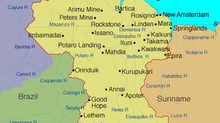A web-GIS approach to mapping dengue outbreaks
Dengue fever was first recorded in Pakistan in 1982, with about a dozen cases confirmed. The disease has been spreading in scope and intensity over the last few decades, with a major outbreak in 2010 launching a new period of frequent and severe outbreaks for this high burden country. Efforts are being stepped up to both prevent infections within communities as well as harness numerous and innovative approaches to predict when and where outbreaks might occur to best channel resources. In this Infectious Thoughts interview, we speak to Dr. Muhammad Butt from the University of the Punjab's Institute of Space Science in Lahore, Pakistan, about recent research seeking to combine remote sensing and GIS to improve epidemic control.

Your work focuses on the district of Lahore in Pakistan - what has been the experience of Lahore in terms of dengue outbreaks and how is the situation in Pakistan overall in terms of dengue burden? Why did you choose this area in particular?
The city of Lahore has over 10 million population with the highest population density in the Punjab Province of Pakistan. It is Pakistan's second largest city, and in fact one of the world's most populated cities. Last year, 1,609 cases were reported across Punjab - this is a high-burden area of Pakistan. Three people have died in the province due to dengue in the past two months and in fact the Punjab health department says four cases were confirmed in Lahore in the past 24 hours.
This remains a public health priority for local authorities: cases have been lodged against 41 people in Lahore after dengue larvae were found during a series of raids. Seven people have been taken into custody. The raids were conducted by the anti-dengue cell. In Gulberg, a plaza and a restaurant were sealed because of unsanitary conditions.
The Lahore government is working to prevent dengue breeding grounds from being formed. The city’s deputy commissioner said they will check wherever water has collected and if dengue larvae are found, cases will be registered.
What were the advantages of using a GIS mapping method to track high-risk areas for dengue outbreaks?
Environmental factors are very important in dengue transmission and outbreaks for example due to the impact on mosquito breeding grounds. Our approach in terms of using environmental factors (including variables such as land surface temperature, rainfall, land use/land cover, population density...) and mapping these in a GIS system has been very useful in determining the major influences on dengue outbreaks. Our aim is to apply this directly to outbreak prevention. Using maps is a rapid and effective way of organising the numerous data.
What have been some of the main results highlighted by this approach?
Certain trends were apparent: dengue outbreaks were most often found where there was inadequate water management practices or stagnant water. This was evident and exacerbated in poorer densely populated areas of the city due to inadequate sanitation and water management practices. But interestingly, more affluent areas were also detected due to the presence of swimming pools, fountains, stagnant water in other forms... In general, water quality is considered as a major issue in the mega cities of developing countries. The objectives of the study were to assess the temporal variations in environmental parameters including water-related variables and to then allow viewing, questioning, understanding, visualizing and interpreting the data into numbers of ways which will reveal relationships, trends and patterns in the form of globes, maps, charts and reports.
Are there limitations to this method?
In general with GIS approaches, this method requires a large amount of data inputs which can have its difficulties. Other errors can occur when mapping is scaled out as errors can occur due to the spherical shape of the Earth, errors which can increase as you get in a larger scale. There might also be technical difficulties or difficulties in order to fully interpret or implement the GIS but there might be large benefits to anticipate as well. These are some of the difficulties which could be experienced when working with GIS technology in general and are not specific to this research. The above mentioned disadvantages could be considered on a case to case basis, based on how the GIS technology will be used.
How easily can this work be included into wider disease and vector control programmes?
Integrated vector control, vector surveillance and disease prevention significantly depend on data. With GIS, data can be analyzed and presented in a visual manner and placed in context for a specific audience.
As part of integrated vector control program, GIS technology can specifically help to track larval habitats and larval control applications. Also, field technicians can use GPS coordinates to collect data related to larval habitats and larvicide applications. Data can include marking a location that was visited, noting if a location had larval activity, or tracking how much product was applied to a given area. By tracking the mosquito populations, decisions on interventions are improved.
GIS approaches can support data management and analysis to support all aspects of vector control, not only on the ground but also administratively, including regulatory compliance, inventory management, as well as public education and public health risks...
---
Towards a Web GIS-based approach for mapping a dengue outbreak
Butt, M.A., Khalid, A., Ali, A. et al. Appl Geomat (2019)


























